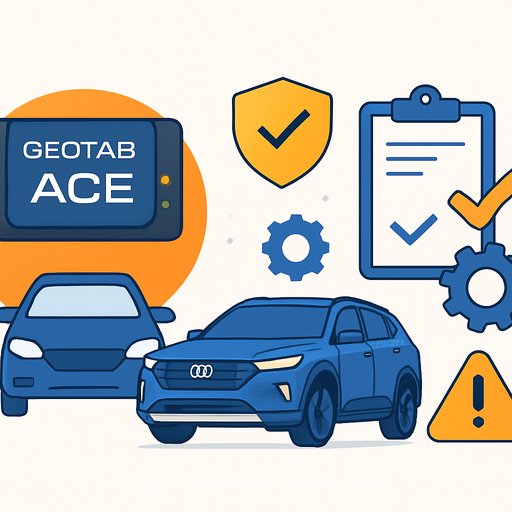Geotab Ace Brings Conversational AI to Australian Fleets
Australian fleet leaders now have access to Geotab Ace, a generative AI assistant integrated into the MyGeotab platform. It turns complex telematics into clear answers you can act on-fast. Ask questions in plain language and get data-backed responses in seconds.
"By combining trusted data with the intuitive simplicity of conversational AI, we're helping customers overcome local challenges, unlock new efficiencies, and accelerate progress toward safer, smarter, and more sustainable transport operations," said Chris Martin, Senior Manager, Solutions Engineering - APAC at Geotab.
This launch meets rising pressures head-on: fuel price volatility, driver shortages, and stricter safety rules. Geotab Ace interprets billions of daily data points to deliver insights on predictive safety and maintenance, trip and zone activity, EV metrics, and exception events. It also learns from prior interactions to improve future responses.
Privacy is central. All telematics data stays within Geotab's environment and is not shared with external large language models. With more than 100 billion data points processed daily from over 5 million connected vehicles across 160 countries, Geotab's scale supports stronger predictive models that serve fleets of any size. For more details, visit Geotab Australia.
Example prompts your team can use right now: "Which vehicles had the highest idling time this month?" or "How many EVs exceeded optimal charging thresholds last week?" The payoff is less time building manual reports and faster operational decisions.
How Managers Can Pilot Geotab Ace in 30 Days
- Identify three friction points: idling, harsh events, and EV charging discipline.
- Set thresholds and alerts (e.g., idle > 10 minutes, SOC charge > 90%).
- Create weekly Ace prompts and a simple scorecard: fuel per 100 km, preventable faults, % trips inside geofenced zones.
- Run a two-week trial with one depot; compare before/after metrics.
- Document SOPs for dispatch, safety, and maintenance teams; roll out across sites.
If you're upskilling your team on AI for operations, see focused programs at Complete AI Training.
Hyundai Introduces 7-Year Warranty in Australia
Hyundai Motor Company Australia has launched a 7-year unlimited kilometre warranty for passenger vehicles from 1 September 2025. It covers SUVs, hybrids, and EVs, strengthening long-term value and residual confidence for fleet buyers.
Hyundai indicates the program will be backdated to cover recent registrations. Fleet managers should confirm exact eligibility dates and terms with their dealer network to lock in lifecycle and resale assumptions.
Maintenance and Asset Management: Moving From Reactive to Proactive
At the Light Commercial Motorshow in Sydney, an expert panel addressed how fleets can shift from reactive costs to a data-driven maintenance strategy that protects uptime. The direction is clear: use live vehicle data, standardize rules, and measure outcomes weekly.
- Predictive scheduling: Base service windows on duty cycles and fault trends, not just odometer or time.
- Exception management: Trigger work orders from repeated DTCs, overheating, or brake wear indicators.
- Right-size inventory: Align parts stock with actual failure patterns by model and route profile.
- Technician enablement: Standard checklists, torque specs, and repair times accessible from the bay.
- Finance alignment: Tie maintenance KPIs to TCO levers-fuel, tires, unplanned downtime, and resale.
Bendix: Brake Fluid Safety and DOT Ratings
Brake fluid sits low on many maintenance lists but it's critical for safety. Bendix highlights why choosing the correct DOT rating matters.
- DOT 3, DOT 4, and DOT 5.1 are glycol-based and generally mix-compatible, but always follow the vehicle's spec; higher DOT typically means higher boiling points.
- DOT 5 is silicone-based and not compatible with glycol fluids; do not mix.
- Action for managers: Test fluid for moisture content, replace on schedule (commonly every 24 months or as per OEM), and label reservoirs clearly by spec.
National Windscreens Group Expands Into Tasmania
National Windscreens Group has acquired Action Auto Glass in Burnie and Devonport, plus Action Auto Sliders in Queensland. For fleets, the expanded footprint means broader coverage and faster repair or replacement-key to minimizing downtime.
Update your supplier matrix and SLAs to reflect Tasmanian coverage. Ensure booking processes, billing profiles, and response-time targets are aligned with your uptime requirements.
GWM Service Program Updates: Lower Maintenance Burden
GWM has updated servicing for the 2025 Cannon ute and Tank 300 SUV with the 2.4-litre turbo-diesel. First service is now at 10,000 km or 12 months (previously 5,000 km or 6 months), with subsequent services every 15,000 km.
For managers, that reduces workshop visits and short-interval costs. Adjust your PM schedules, parts planning, and warranty checks accordingly, and sync the changes with your maintenance portals and supplier bookings.
Manager's Checklist: What to Action This Week
- Trial Geotab Ace with a clear 30-day success metric (fuel, safety events, or EV charging compliance).
- Confirm Hyundai's 7-year warranty eligibility against your current and pending orders.
- Review brake fluid specs across your fleet; schedule moisture testing where unknown.
- Add NWG Tasmania locations to your glass repair playbook and escalation paths.
- Update GWM service intervals in your CMMS and notify drivers of revised booking timelines.
Your membership also unlocks:






